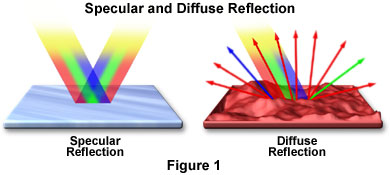- 5,676
- 4,913
Laser/Light Beam Dodging Feats | VS Battles Wiki | Fandom
I have noticed something on the light feats page that is admittingly vague
"The beam reflects off a material that it can be expected to, such as a non-magical mirror"
One of the conditions to qualify as real light is to reflect off a surface, but the page doesn't specify as to what it means by that.
To illustrate what I mean:

Molecular Expressions Microscopy Primer: Light and Color - Specular and Diffuse Reflection: Interactive Tutorial (fsu.edu)
Proper light will reflect off different types of surfaces, doing so at angles for flat surfaces, and irregular for non standard surfaces.
Would like the input of staff regarding if reflection should be branched out
Furthermore, its come to my attention there seems to be different interpretations of how reflection is accepted. Should it be something like light bending from a surface, shooting out an angle, etc?
Reflection of Light - Introduction | Olympus LS (olympus-lifescience.com)
There are of course studies on this.
Also want to discuss stuff like partial reflections. that is to say light partially reflects on as surface, and reflections leaving smoke.
reflection is when radiation bounces off of something without being absorbed, so for the surface to smoke, it would have had to absorb heat from the beam. Obviously reflective surfaces aren't indestructible and it's possible to melt things like mirrors with enough intensity, but most radiation will reflect off of them rather than cause damage, and there would have been some level of actual reflection regardless, the beam wouldn't just stop at the surface and not go anywhere else.
I also think its worth discussing the the distinction between something reflecting and it spreading out in an impact
My proposal is a stricter interpretation of reflection, as bending, curving, etc wouldnt prove its light
I have noticed something on the light feats page that is admittingly vague
"The beam reflects off a material that it can be expected to, such as a non-magical mirror"
One of the conditions to qualify as real light is to reflect off a surface, but the page doesn't specify as to what it means by that.
To illustrate what I mean:

Molecular Expressions Microscopy Primer: Light and Color - Specular and Diffuse Reflection: Interactive Tutorial (fsu.edu)
Proper light will reflect off different types of surfaces, doing so at angles for flat surfaces, and irregular for non standard surfaces.
Would like the input of staff regarding if reflection should be branched out
Furthermore, its come to my attention there seems to be different interpretations of how reflection is accepted. Should it be something like light bending from a surface, shooting out an angle, etc?
Reflection of Light - Introduction | Olympus LS (olympus-lifescience.com)
There are of course studies on this.
Also want to discuss stuff like partial reflections. that is to say light partially reflects on as surface, and reflections leaving smoke.
reflection is when radiation bounces off of something without being absorbed, so for the surface to smoke, it would have had to absorb heat from the beam. Obviously reflective surfaces aren't indestructible and it's possible to melt things like mirrors with enough intensity, but most radiation will reflect off of them rather than cause damage, and there would have been some level of actual reflection regardless, the beam wouldn't just stop at the surface and not go anywhere else.
I also think its worth discussing the the distinction between something reflecting and it spreading out in an impact
My proposal is a stricter interpretation of reflection, as bending, curving, etc wouldnt prove its light
Last edited: